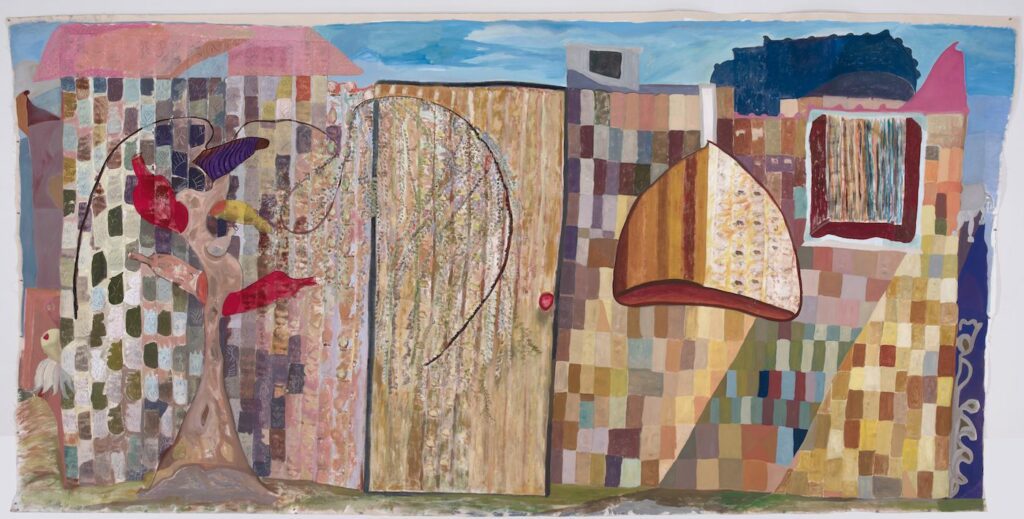Museum of the African Diaspora (MoAD), San Francisco, CA, United States
19 Sep 2018 - 16 Dec 2018

Ficre Ghebreyesus, Zememesh Behr's Magic Garden. n.d. Acrylic on canvas, 190 x 95 inches. Courtesy Elizabeth Alexander. Ficre Ghebreyesus Estate
The Museum of the African Diaspora (MoAD) presents the first museum showing and first west coast exhibition of the paintings of Eritrean American artist Ficre Ghebreyesus (1962-2012), who fled conflict in his country and made his way to the United States as a political refugee. Ficre Ghebreyesus: City with a River Running Through brings together more than a dozen of his finest works, with a particular focus on Ghebreyesus’ abstractly rendered and vivid painted landscapes, replete with water imagery and aquatic life.
Visitors first encounter one of Ghebreyesus’ most impressive paintings, City with a River Running Through upon entering the exhibition. This massive painting, divided into four panels, is over 18 feet long and is a cartographical tour-de-force, depicting, from multiple perspectives, a cityscape made up of an abstract patchwork of colors, patterns, and shapes.
Many of the paintings on display are abstracts, studies of geometric color that highlight the artist’s delight in the material qualities of acrylic paint on canvas. Other works are more figurative, seeming to hint at dreamlike fables: a Coptic angel swims with a school of fish; a nude woman stands in front of a bottle tree while a Yoruba rider and horse look on; a young man reads a book as he walks into a tangle of corals and seaweed.
In all of these evocative, and often surreal, landscapes, the viewer senses a myriad of influences on Ghebreyesus’ work from the craft markets of Eritrea to the musical polyrhythms of the Black diaspora. This cultural layering speaks directly to the forces that shaped the artist’s life.
Between 1961 and 1991, the War of Independence raged in the Horn of Africa. Ghebreyesus was born in Asmara, Eritrea in 1962 right as this conflict began. In 1978, he left the country as a political refugee and lived in Sudan, Italy, and Germany before coming to the United States in 1981, working as a humanitarian activist on behalf of Eritrean independence and on-going relief issues. He returned to Eritrea in the 90s when the war had concluded, but remnants of the conflict could still be seen throughout the country.
Tellingly, in 2000, Ghebreyesus wrote in his application for admission to the Yale School of Art: I started painting ten years ago, but I suspect I have been metaphorically doing so all my life. When I started painting, I just did it. I had never felt a stronger urge. The pieces that flowed out of me were very painful and direct. They had to do with the suffering, persecution, and subsequent psychological dilemmas I endured before and after becoming a young refugee from the Independence War in my natal home of Eritrea, East Africa. Painting was the miracle, the final act of defiance through which I exorcised the pain and reclaimed my sense of place, my moral compass, and my love for life.
Ghebreyesus is the late husband of poet and Pulitzer Prize finalist Elizabeth Alexander. In her best-selling memoir The Light of the World, Alexander gave her devoted readers a tender portrait of the artist she loved, married, and unexpectedly lost in 2012. Alexander’s poignant meditation on the sudden death of her husband familiarized many with the harrowing story of his flight from war, his long journey to the United States, and the life of love and art he found here. And yet, despite this widespread intimacy, few have seen the work of this prolific and singular painter until now.
“Ghebreyesus’ life and work speak so deeply about African diasporic experiences in our very recent past to today,” says MoAD Director and CEO Linda Harrison. “More often we think about West Africa. But Ficre’s life and work reminds us of the essential nature of the entire continent and life in East Africa, the Horn of Africa, and its adjacencies in the Middle East. Then there are his travels through Europe and the United States. It is the textured geographies and the navigation of cultural exchange within diaspora that we all share. The artist evokes this spirit so beautifully, and especially through his vivid use of color and by choosing water and the voyage as a consist themes in his work.”
About Ficre Ghebreyesus
Along with his work on behalf of his country and its people after arriving in the United States, Ficre Ghebreyesus studied painting at the Art Students’ League and printmaking at the Robert Blackburn Printmaking Workshop, both in New York City. He later studied at Yale University, where he earned his MFA in 2002 and was awarded the Carol Schlossberg Prize for Excellence in Painting at graduation.
Ghebreyesus made his life in New Haven for almost thirty years, where he lived with his wife Elizabeth Alexander and their sons Solomon and Simon. From 1992-2008, he was executive chef and co-owner with his brothers of the immensely popular CafféAdulis that brought creative Eritrean cuisine to New Haven and New York City. In the last years of his life, he dedicated his work time solely to his art. He died unexpectedly in April 2012.
Museum of the African Diaspora
685 Mission St (at 3rd)
San Francisco, CA 94105
Monday – Tuesday: Closed
Wednesday – Saturday: 11 am – 6pm
Sunday: 12pm – 5 pm